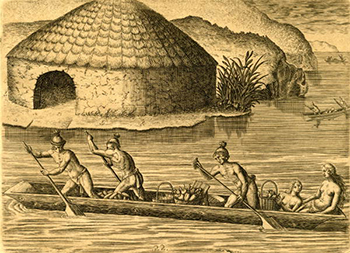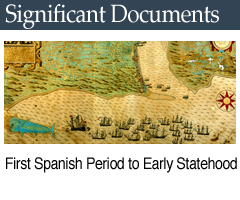Theodor de Bry's Engravings of the Timucua
In 1591 Dutch engraver and goldsmith Theodor de Bry published Grand Voyages, which contained the earliest known European images of Native Americans in what is now Florida.
In 2013, Florida commemorated the 500-year anniversary of the arrival of Europeans and Africans in the Americas. Juan Ponce de León's expedition to Florida in 1513 marked a major turning point in world history. When Europeans and Africans met Native Americans on the shores of the land we now call Florida, life on both sides of the Atlantic Ocean was forever changed.
De Bry’s Grand Voyages
For Grand Voyages and later publications de Bry relied on accounts by men like John White, a member of the failed Virginia colony at Roanoke; Hans Staden, who endured nine months of captivity among the Tupinambá Indians of Brazil; and Jacques Le Moyne de Morgues, a member of the short-lived French colony in Florida, Fort Caroline.
This collection features 42 plates from the first German-language edition of Grand Voyages, published in 1591. De Bry obtained Le Moyne’s original sketches shortly after his death in 1588. Le Moyne served as the artist for René de Laudonnière’s expedition to Florida in 1564. In September 1565, Spanish soldiers led by Pedro Menéndez de Avilés laid waste to the French colonists in an event known as the Fort Caroline Massacre. Le Moyne survived the attack and sought refuge in England.
Perception and Controversy
De Bry’s renditions of Le Moyne’s sketches are both historically significant and highly controversial. Scholars point out that certain aspects of the engravings do not match later depictions of the Timucua Indians encountered by the French in northeastern Florida, and also contend that de Bry certainly altered the images prior to publication. Artistic license is evident in several of the images included here. For example, in the scene depicting Timucua warfare against the Potanou [Plate XIII], mountains are visible in what is supposed to be northeastern Florida. Other images also contain items not found in Florida, such as the Pacific nautilus rather than the Florida whelk shell as a Timucuan ceremonial object [Plates XIX and XL].
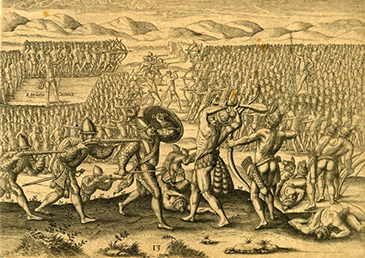
In other instances, more reliable clues about Timucuan culture emerge. For example, in Plate XVIII, “The Chief Applied to by Women Whose Husbands Have Died in the War or by Disease,” the Timucua chief is adorned with numerous tattoos. Because Europeans were largely unfamiliar with tattooing for decorative purposes, it is unlikely that either Le Moyne or de Bry fabricated Timucuan body art. Later ethnographic information confirms that tattooing was common among the southeastern Indians.
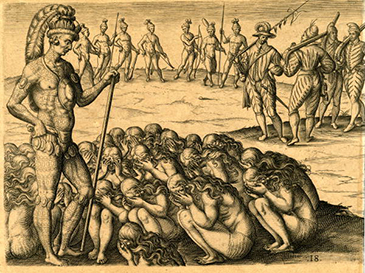
Regardless of authenticity, the images created by Le Moyne and published by de Bry constitute the earliest known visual representations of Florida and its indigenous people. Although the illustrations provide only a small window into the lives of the Timucua, they reveal a wealth of information about European aspirations to colonize Florida. Indeed, we learn more about Europeans than Native Americans from de Bry’s engravings.
Engravings such as Plate XIV, “Order of March Observed by Outina on a Military Expedition,” were meant to promote colonization. This image conveyed the notion that the Timucua obeyed authority, were organized and fit for war, and could perhaps aid the Protestant French against their Catholic enemies vying for control of the Americas. The images depict the Timucua as less sophisticated than Europeans, both in terms of dress and weaponry, and therefore they were seen as potential candidates for accepting French religion and civilization.
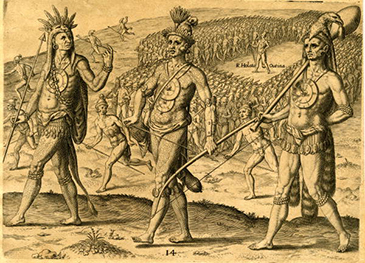
The Michael W. and Dr. Linda Fisher Collection
The digital copies of the de Bry engravings included here are made possible by a donation from the Michael W. and Dr. Linda Fisher Collection. All transcriptions are taken from Discovering the New World, Based on the Works of Theodore de Bry, edited by Michael Alexander (New York: Harper & Row, 1976).
First Voyage, 1562
- Plate I The Promontory of Florida, at which the French Touched; Named by Them the French Promontory
- Plate II The French Sail to the River of May
- Plate III Leaving the River of May, the French Discover Two Other Rivers
- Plate IV Six Other Rivers Discovered by the French
- Plate V The French Reach Port Royal
- Plate VI The French Commander Erects a Column with the Arms of the King of France
- Plate VII The French Left in Fort Charles Suffer from a Scarcity of Provisions
Second Voyage, 1564
- Plate VIII The Natives of Florida Worship the Column Erected by the Commander on his First Voyage
- Plate IX The French Select a place for Building a Fort
- Plate X Picture of Fort Caroline
- Plate XI Ceremonies Performed by Saturioua Before Going on an Expedition Against the Enemy
- Plate XII Outina, going at the Head of His Army, Against the Enemy, Consults a Sorcerer on the Event
- Plate XIII Outina, With the Help of the French, Gains a Victory over His Enemy Potanou
- Plate XIV Order of March Observed by Outina on a Military Expedition
- Plate XV How Outina’s Men Treated the Slain of the Enemy
- Plate XVI Trophies and Ceremonies after a Victory
- Plate XVII Employments of the Hermaphrodites
- Plate XVIII The Chief Applied to by Women Whose Husbands Have Died in the War or by Disease
- Plate XIX Ceremonies of Women Mourning for their Deceased Husbands
- Plate XX Mode of Treating the Sick
- Plate XXI Mode of Tilling and Planting
- Plate XXII Industry of the Floridians in Depositing Their Crops in the Public Granary
- Plate XXIII Bringing in Wild Animals and Other Stores
- Plate XXIV Mode of Drying Fish, Wild Animals, and other Provisions
- Plate XXV Hunting Deer
- Plate XXVI Killing Crocodiles
- Plate XXVII Floridians Crossing Over to an Island to take their Pleasure
- Plate XXVIII Preparations for a Feast
- Plate XXIX Proceedings of the Floridians in Deliberating on Important Affairs
- Plate XXX Construction of Fortified Towns among the Floridians
- Plate XXXI How They Set on Fire an Enemy’s Town
- Plate XXXII How Sentinels are Punished for Sleeping on Their Posts
- Plate XXXIII How They Declare War
- Plate XXXIV First-Born Children Sacrificed to the Chief with Solemn Ceremonies
- Plate XXXV Solemnities at Consecrating the Skin of a Stag to the Sun
- Plate XXXVI The Youth at Their Exercises
- Plate XXXVII The Display with Which a Queen Elect is Brought to the King
- Plate XXXVIII Solemnities at the Reception of the Queen by the King
- Plate XXXIX The King and Queen taking a Walk for their Amusement
- Plate XL Ceremonies at the Death of a Chief or of Priests
- Plate XLI Mode of Collecting Gold in Streams Running From the Apalatcy Mountains
- Plate XLII Murder of Pierre Gambre, a Frenchman

 Listen: The Latin Program
Listen: The Latin Program